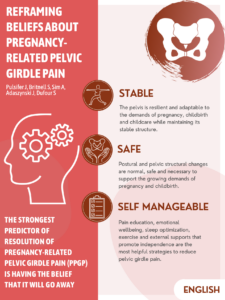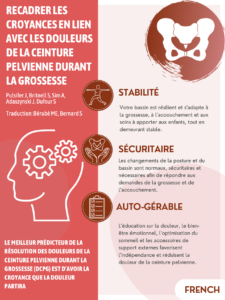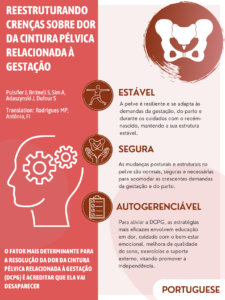Author: Jodie Pulsifer, MPT Registered Physiotherapist
The creation of the Pelvic Girdle Pain in Pregnancy Infographic published in BJSM August 2022 (1) was a labour of love by my colleagues with collective minds and hearts. It was an adventure of knowledge mobilization from established clinical practice guidelines and commonly held beliefs seen daily in our clinical practices. For a tiny editorial, when brevity is not my forte, we poured over our words to ensure they did not misconstrue the research while aligning with the knowledge that belief in change paired with positive, action oriented information and support is impactful for pain management.
Why Language Matters
It was our hope this would be a meaningful and useable tool and to our delight, we have had many health providers reach out to use the tool in both provider and patient education platforms. We have also been thrilled to have a number of requests for translation.
It is not new knowledge that language matters in pain management (2). Therapeutic pain neuroscience education is an integral part of changing someone’s experience with pain (3). Provider language skills that are matched to ever evolving context and culture have the potential to play an important role in shaping and supporting someone’s pain experience. A provider’s ability to convey health messages by adjusting language to uniquely meet a person can improve pain knowledge, decrease catastrophization, shift attitudes and beliefs that enable reintegration of movements without fear or prolonged disability (3).
Translated Texts Support Knowledge Mobilization
It is with this knowledge that we have set out to create translated texts to allow providers to educate in the language of best understanding. This process is one of learned trust and a hope that the translations from our deeply considered English text, through the lens of our team members in 2022, could be useful in other languages and cultures today. Our supporting translators are health professionals who have given their time and knowledge of their own languages and cultures to translate the text that aims to maintain the importance of a fear reduced narrative while staying culturally appropriate in their own languages.
Gratitude and Future Translations
It is with gratitude that I thank the translators for their time and considerations in this project. At this time we have translated texts in English, French, Hungarian, Italian, Polish and Portuguese. Please see these alternative versions below.
Alternative Versions
English Translation (original version)
Corresponding author Jodie Pulsifer [jodie@fullcirclephysiotherapy.com]
Click here for the full English infographic PDF

French Translation
Please send any queries to Jodie Pulsifer [jodie@fullcirclephysiotherapy.com]
Click here for the full French infographic PDF

Hungarian Translation
Corresponding author Edina Iván [ivanedinaie@gmail.com]
Click here for the full Hungarian infographic PDF

Italian Translation
Please send any queries to Jodie Pulsifer [jodie@fullcirclephysiotherapy.com]
Click here for the full Italian infographic PDF

Polish Translation
Corresponding author Malgorzata Starzec-Proserpio [m.starzec@outlook.com]
Click here for the full Polish infographic PDF

Portuguese Translation
Corresponding author Marina Petter Rodrigues [mpetterrodrigues@gmail.com]
Click here for the full Portuguese infographic PDF

Feedback and Call for Future Translations
Feedback is welcome directly to myself in English and to several of the translating authors in their own languages. For languages whose translators are not content experts, questions can be directed through myself and I will do my best to support.
The BJSM has kindly allowed us to have these infographics available open access through the Blog and can be updated as new languages are available. If you wish to see this infographic text translated into your own language and can volunteer to be involved in the process, please reach out.
Acknowledgements
Many thanks to Stéphanie Bernard, Marie-Ève Bérubé, Edina Iván, Zsófia Agg, Alice Boglione, Malgorzata Starzec-Proserpio, Marina Petter Rodriguez and Flavia Ignacio Antonio. And thanks always to my co-authors Susannah Britnell, Adrienne Sim, Jessica Adaszynski and Sinead Dufour who tirelessly considered every word of our original editorial and infographic to ensure representation of positive action oriented language that left space for each person’s lived experience, dispelled myths, brought forward facts and maintained gender inclusion for birthing folks. Final thanks to my partner, Josh Pulsifer, for volunteering his time creating icons on demand.
References
- Pulsifer, J., Britnell, S., Sim, A., Adaszynski, J., & Dufour, S. (2022). Reframing beliefs and instiling facts for contemporary management of pregnancy-related pelvic girdle pain. British journal of sports medicine, 56(22), 1262–1265. https://doi.org/10.1136/bjsports-2022-105724
- Wilson, D., Williams, M., & Butler, D. (2009). Language and the pain experience. Physiotherapy research international : the journal for researchers and clinicians in physical therapy, 14(1), 56–65. https://doi.org/10.1002/pri.424
- Louw, A., Zimney, K., Puentedura, E. J., & Diener, I. (2016). The efficacy of pain neuroscience education on musculoskeletal pain: A systematic review of the literature. Physiotherapy theory and practice, 32(5), 332–355. https://doi.org/10.1080/09593985.2016.1194646